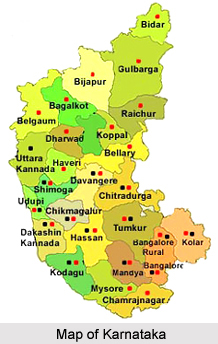 Karnataka is located in the southern part of India and has the states of Tamil Nadu, Maharashtra, Andhra Pradesh and Kerala as neighbours. The capital of the state is the city of Bengaluru, which has evolved as one of the most vibrant cities in the country. Bangalore has grown into a hub for many major companies mainly IT companies.
According to Census 2011, at about 61 million, making it the ninth most populated state in India. The state is spread over an area of about 190000 sq. km. making it the eighth largest state in the country in terms of area.
Karnataka is located in the southern part of India and has the states of Tamil Nadu, Maharashtra, Andhra Pradesh and Kerala as neighbours. The capital of the state is the city of Bengaluru, which has evolved as one of the most vibrant cities in the country. Bangalore has grown into a hub for many major companies mainly IT companies.
According to Census 2011, at about 61 million, making it the ninth most populated state in India. The state is spread over an area of about 190000 sq. km. making it the eighth largest state in the country in terms of area.
The density of population per sq. km. is about 300 and a lot below the national average. The state has a growth rate of about 15% percent, which is the 22nd highest growth rate in the country. The population of the state is rising considerably due to rapid efforts towards development and progress.
The literacy rate in the state is about 75%, which is a cause for concern and a statistic the authorities must take notice of and look to correct in the years to come. The sex ratio in Karnataka stands about 20 points higher than the national average.
The languages spoken in the Karnataka state includes Kannada language. As per details from Census 2011, Karnataka has population of 6.11 crore, an increase from figure of 5.29 Crore in 2001 census. Total population of Karnataka as per 2011 census is 61,130,704 of which male and female are 31,057,742 and 30,072,962 respectively. In 2001, total population was 52,850,562 in which males were 26,898,918 while females were 25,951,644.
Literacy rate in Karnataka has seen upward trend and is 75.60 percent as per 2011 population census. Of that, male literacy stands at 82.85 percent while female literacy is at 68.13 percent. In 2001, literacy rate in Karnataka stood at 66.64 percent of which male and female were 76.06 percent and 57.80 percent literate respectively.
The sex Ratio in Karnataka is 968 i.e. for each 1000 male, which is below national average of 940 as per census 2011. In 2001, the sex ratio of female was 964 per 1000 males in Karnataka.



















